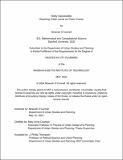| dc.contributor.advisor | Ocampo, Mary Anne | |
| dc.contributor.author | O'Connell, Nineveh | |
| dc.date.accessioned | 2024-08-14T20:10:39Z | |
| dc.date.available | 2024-08-14T20:10:39Z | |
| dc.date.issued | 2024-05 | |
| dc.date.submitted | 2024-06-28T21:02:44.214Z | |
| dc.identifier.uri | https://hdl.handle.net/1721.1/156143 | |
| dc.description.abstract | Public transit offers a valuable method to sustainably connect people to highly sought amenities, including outdoor spaces. Outdoor recreation has grown in popularity, with a particular uptick in outdoor activity in response to the Covid-19 pandemic. Additionally, a growing body of research has demonstrated the public health benefits of access to open space. Auto-dependency in the United States often requires visitors to arrive to outdoor spaces via personal vehicle, generating carbon emissions and limiting outdoor access for communities without reliable access to cars. Further, high demand for outdoor access has resulted in visitors parking in unauthorized spots along the shoulder of roads when trailhead parking lots reach capacity, creating congestion and unsafe road conditions as people walk between their cars and trailheads alongside moving traffic. City dwellers and the environment would benefit from public transportation services connecting densely populated areas to beloved outdoor spaces. This paper explores how fixed-route public transit has brought urban communities closer to nearby trailheads with two examples in the American West: Trailhead Direct in King County, WA and the Muir Woods Shuttle in Marin County, CA. Both programs were implemented in the twenty-first century in response to unsafe conditions at trailhead parking lots, yet they have grown to operate under very distinct models. Sequencing the evolution of these transit to trails programs relative to stated program goals provides insight into the degree to which they have been successful, and what further work could be done to improve visitor experience, prioritize ecosystem protection, and increase equitable access to the outdoors. Adaptation to unforeseen circumstances, creative marketing and routing tailored to a clear customer group, and securing funding from relevant stakeholders have constantly influenced both programs. These case studies showcase the value of partnerships between land managers and transit agencies, and analysis of their history highlights key components to consider when designing sustainable, reliable transit to trails service. | |
| dc.publisher | Massachusetts Institute of Technology | |
| dc.rights | In Copyright - Educational Use Permitted | |
| dc.rights | Copyright retained by author(s) | |
| dc.rights.uri | https://rightsstatements.org/page/InC-EDU/1.0/ | |
| dc.title | Wildly Inaccessible: Reaching Public Lands via Public Transit | |
| dc.type | Thesis | |
| dc.description.degree | M.C.P. | |
| dc.contributor.department | Massachusetts Institute of Technology. Department of Urban Studies and Planning | |
| dc.identifier.orcid | https://orcid.org/0009-0001-1830-2790 | |
| mit.thesis.degree | Master | |
| thesis.degree.name | Master in City Planning | |
